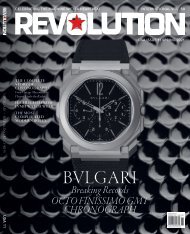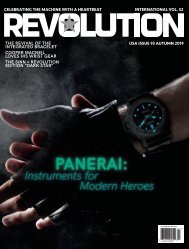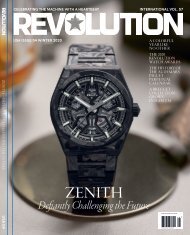You also want an ePaper? Increase the reach of your titles
YUMPU automatically turns print PDFs into web optimized ePapers that Google loves.
2014: OCTO FINISSIMO<br />
MECHANICAL HAND-WOUND<br />
Buonamassa, Bvlgari’s design director, explains, “The<br />
objective of thinness was not arrived at in isolation. After all,<br />
there are many brands that have been associated with ultrathin<br />
watches, especially in the 20th century. The objective<br />
was to enhance this dynamic tension, this unique proposition<br />
between having a watch that was, when viewed straight on,<br />
very muscular and even aggressive, yet when you turned it on<br />
its side, it was really surprising in how thin it was. I wanted, as<br />
Jean-Christophe expressed, to bring something to watches<br />
that the world had never seen in terms of this proposition.”<br />
But this objective of dynamic tension between bold and<br />
thin necessitated Bvlgari to push the technical envelope in<br />
every component of the Octo Finissimo. Says Babin, “The<br />
Octo Finissimo was only possible because we own our<br />
movement maker, dial maker, casemaker [and] bracelet<br />
maker, as it would be impossible to convince outside<br />
suppliers to make the effort we needed.”<br />
What kind of effort are we talking about? For example,<br />
the entire dial of the Octo Finissimo is 0.2mm (0.3mm if<br />
a coat of lacquer is applied) which makes it thinner than<br />
a single index on the majority of other watches. In order<br />
for this to be achieved, the indexes and even the “Bvlgari”<br />
signature have to be galvanically grown and transferred over<br />
to the dial, almost as if they were stickers. In the instance of<br />
the Octo Finissimo, it is just the seconds track in the subdial<br />
that is printed. The very first Octo Finissimo was a manual<br />
wind (now replaced by a micro-rotor, automatic-winding<br />
model) with a BVL 128 movement that was 2.23mm and a<br />
final watch that was 5.15mm in total thickness. In order to<br />
achieve this, even the way in which the watch was assembled<br />
had to be completely rethought.<br />
Says Buonamassa, “Of course we wanted a sapphire<br />
back to showcase the beauty of our in-house caliber with its<br />
beautiful ‘full bridge’ architecture. However, to conserve<br />
space, the sapphire back is integrated into the case, basically<br />
pre-fitted into the monobloc case. Next, the movement is<br />
placed into the case, [then] the dial and hands are added<br />
and finally the bezel and sapphire are placed on top. It is the<br />
bezel that seals the watch.” Each bezel features eight hollow<br />
threaded posts that are inserted through the case and fixed<br />
at the back of the watch with special fasteners that look like<br />
five-sided nuts. I particularly like that because they are not<br />
slotted, they are never out of alignment as you see on other<br />
watches that are fastened in the back in this way.<br />
Above, clockwise<br />
from left<br />
Antoine Pin,<br />
managing director<br />
of Bvlgari’s<br />
Watch Division.<br />
The dial of the Octo<br />
Finissimo measures<br />
a mere 0.2mm thin.<br />
Each dial is<br />
finished by hand.<br />
Opposite<br />
The escapement<br />
is supported with<br />
a balance bridge<br />
that’s screwed<br />
down on both<br />
sides, rather than a<br />
balance cock, which<br />
improves the ultrathin<br />
movement’s<br />
shock resistance.<br />
The barrel bridge<br />
doubles as a power<br />
reserve display.<br />
The Octo Finissimo<br />
Petite Seconds in<br />
rose gold, with hour<br />
markers that are<br />
galvanically grown<br />
and then transferred<br />
to the dial.<br />
30 COVER STORY











